
Employee engagement is the lifeblood of any thriving organization. When employees feel valued, motivated, and connected to their work, magic happens. Productivity soars, retention increases, and a culture of high performance takes hold.
But in order to understand engagement levels and uncover actionable insights, you need the right tool: a thoughtfully designed employee engagement survey. By asking the right questions in the right way, you can gain a clear picture of what's working, what's not, and where to focus your efforts for maximum impact.
Wondering how to create an effective engagement survey that gets to the heart of what matters most to your people? Keep reading for our complete guide.

First, let's zoom out and remind ourselves why employee engagement is so critical in the first place:
Highly engaged teams are 21% more profitable.[^1^]Their people are more productive, innovative, and committed to the company mission. They go above and beyond, pouring their best effort into their work because they believe in what they're doing and feel a deep sense of purpose.
Disengaged employees, on the other hand, cost U.S. companies up to $550 billion per year.[^2^] They're checked out, unmotivated, and more likely to leave for greener pastures. This revolving door of turnover is expensive, draining resources that could be better spent elsewhere.
The bottom line? Employee engagement has a direct impact on your bottom line. It's not a "nice-to-have" — it's a strategic imperative.
But here's the challenge: Only 15% of employees worldwide are engaged at work.[^3^] The vast majority are either not engaged (just going through the motions) or actively disengaged (spreading negativity to others). Houston, we have a problem.
So what's a well-meaning organization to do? Enter: the employee engagement survey.
When done right, these surveys provide a powerful diagnostic tool to:
In short, engagement surveys help you take the pulse of your people and culture. They shine a light on what's really happening beneath the surface, so you can take intentional steps to create a thriving workplace where everyone can do their best work.
Not all engagement surveys are created equal. To get meaningful results, yours needs to be:
Anonymity is essential for honest responses. If employees fear being singled out for their feedback, they'll be far less likely to speak their mind. Make it crystal clear that individual responses will remain confidential.
Aim for 20-30 questions max. Any longer and survey fatigue sets in, leading to abandoned surveys and skewed data. Keep questions clear, concise, and laser-focused on engagement.
Every question should tie back to a specific area you have the power to influence. Avoid generalities in favor of specifics that generate practical insights you can act on.
Include rating scale questions (e.g. agree/disagree) for easy data analysis and open-ended questions for nuanced verbatim feedback. The two complement each other, painting a fuller picture.
Once is not enough. Engagement is dynamic, so re-survey every 6-12 months to track trends. This cadence also shows employees you're committed to acting on their feedback.
Ensure the survey is accessible to all, considering factors like language, reading level, and device type. You want to hear from everyone — not just the loudest voices.

Now for the meat of the matter: writing questions that elicit meaningful responses. A strong survey covers key engagement drivers like:
Within each category, aim for a mix of statements to agree/disagree with (on a 5-point scale) and open-ended questions. For example:
Autonomy:
Recognition:
Communication:
Notice how each question is specific, focusing in on a certain aspect of the broader engagement driver. The goal is to drill down to actionable insights.
For rating scale questions, an agreement scale tends to work best:
1 - Strongly disagree
2 - Disagree
3 - Neutral / Neither agree nor disagree
4 - Agree
5 - Strongly agree
This balanced, 5-point scale gives employees a reasonable range of options while still being easy to analyze. Just be sure to mix in a few negatively worded items (e.g. "I often think about looking for a job at another company") to keep people on their toes and avoid auto-pilot responses.
You've crafted your questions with care — now it's time to get them in front of employees. A few best practices:

The surveys are in — time to dig into the data. But before you jump into number-crunching, take a moment to revisit your objectives. What are you hoping to learn? What decisions will this data inform? Keeping the end in mind will help you focus your analysis for maximum insight and impact.
For rating scale questions (e.g. agreement scales), calculate the average score for each item. This gives you a high-level read on where you're excelling and where there's room for improvement.
But don't stop there. Segment the data to uncover insights beneath the surface. Slice and dice by dimensions like:
Look for patterns and outliers. Where are the biggest gaps? The brightest spots? Resist the urge to get bogged down in the weeds — focus on the forest, not the trees.
For open-ended questions, read through responses to identify common themes. What words or phrases come up again and again? What sentiments are expressed most often?
If you have hundreds of responses, consider using a word cloud tool to visualize the most frequently mentioned terms. This can be a helpful starting point before diving into a deeper read.
As you sift through the verbatims, look for illustrative quotes that bring the quantitative data to life. Numbers tell an important story — but there's nothing quite as powerful as an employee's own words to drive the point home.
The most effective analysis weaves together quantitative and qualitative data to tell a cohesive story. For each key theme (e.g. growth, relationships, communication), what does the rating data show? How is this echoed or expanded upon in the open-ended responses?
Zoom out even further to identify overarching insights that cut across themes. What are the 3-5 key takeaways that leadership needs to know? How do the findings build upon or depart from previous survey results?
Craft a clear, concise executive summary that highlights these topline insights, illustrated by a curated selection of charts, quotes, and callouts. Aim for a narrative that is data-driven yet easy to digest — free of jargon and corporate-speak.
You have your insights — now what? It's time to turn data into action. But before you charge ahead, pause to reflect on what you've learned. Socialize the high-level findings with key stakeholders to get their take. What resonates? What surprises them? Where do they see the biggest opportunities and risks?
Equipped with this context, it's time to prioritize and plan. Resist the urge to boil the ocean — focus on 2-3 high-impact initiatives that address the most pressing gaps. For each, ask:
Importantly, don't forget to close the loop with employees. Share topline findings (respecting confidentiality, of course) and outline your action plan. This demonstrates that you're listening and committed to creating real change.
Continue to keep employees updated as you execute on initiatives. Celebrate quick wins and milestones along the way. And when it's time for the next survey, highlight how past findings have informed tangible improvements. This virtuous cycle builds trust and momentum.
One final note. The most brilliant survey in the world won't move the needle on engagement if employees don't feel safe to tell the truth. To create a culture of honest feedback, you need psychological safety — the belief that you won't be punished or humiliated for speaking up with ideas, questions, concerns, or mistakes.
As a leader, you set the tone. Model vulnerability and fallibility. Invite dissent. Celebrate those who have the courage to voice unpopular opinions. Treat "failures" as learning opportunities. And above all, follow through on the feedback you receive — even (especially) when it's tough to hear.
Building and sustaining employee engagement is a marathon, not a sprint. There are no quick fixes or silver bullets. But with a thoughtful approach to measurement, coupled with a steadfast commitment to action and psychological safety, you can create a workplace where everyone has a voice and a stake in success. Engagement surveys are a vital tool in this journey — so wield them wisely. Your people, and your organization will reap the rewards.


